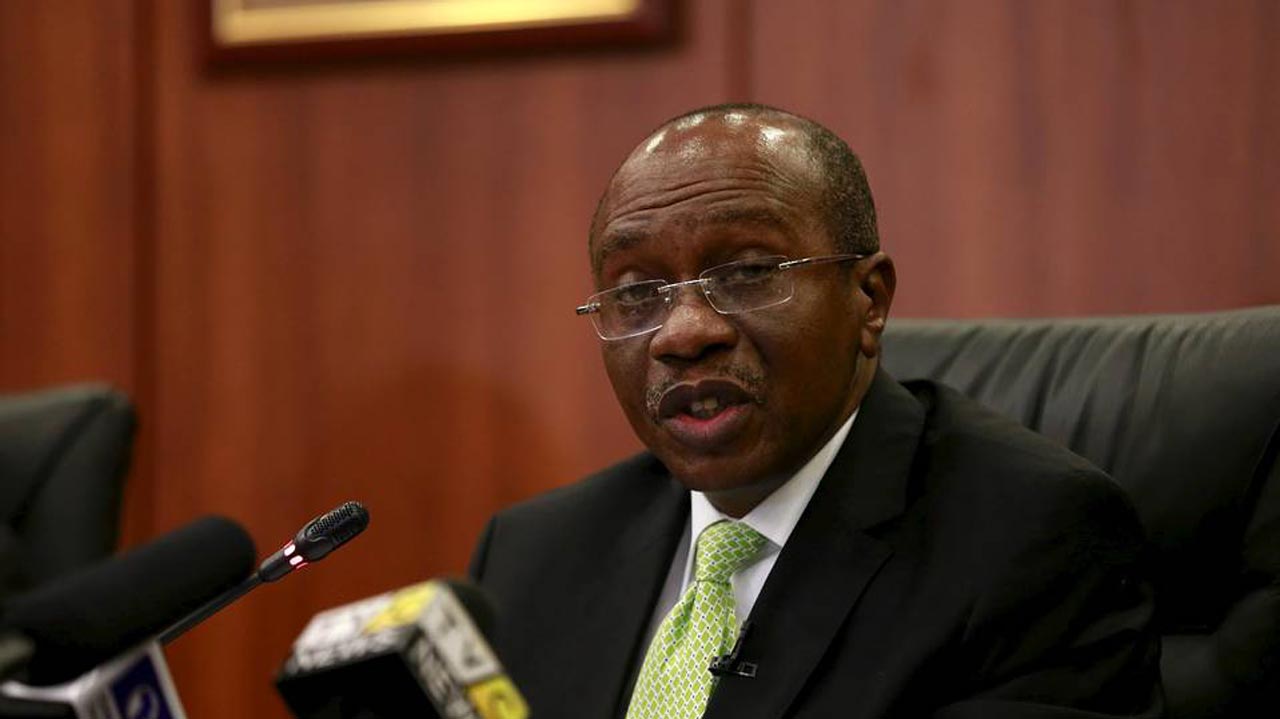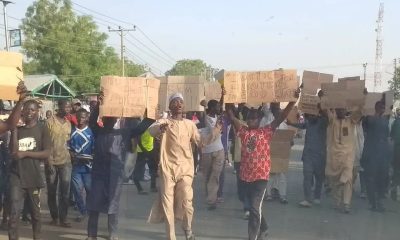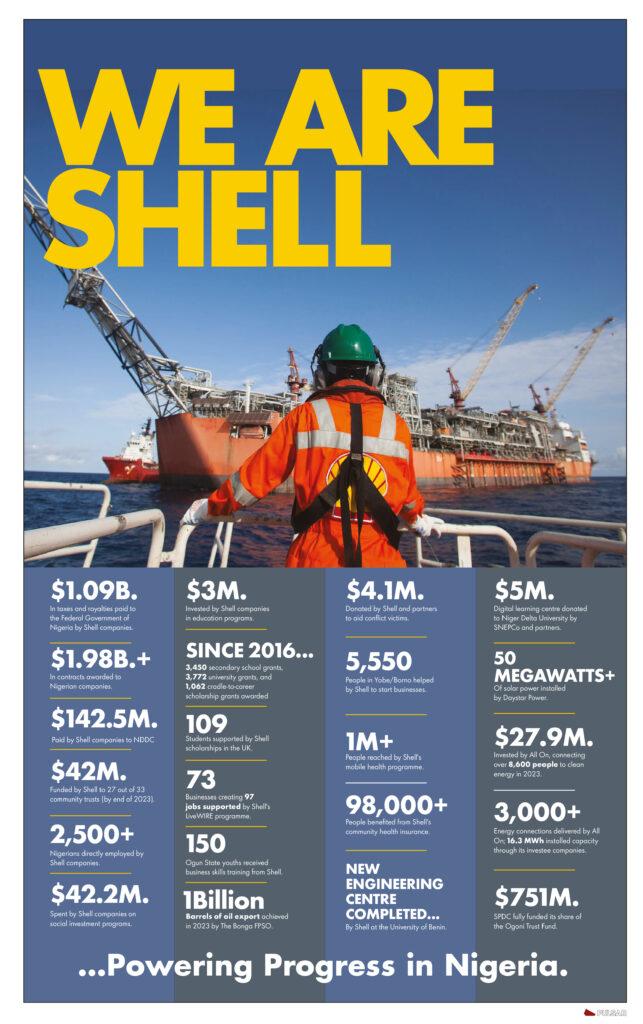Latest News
Emefiele: Non-oil sector leading Nigeria’s economic recovery

Nigeria’s output growth remains on the strong side with the non-oil sector leading the country’s economic recovery, Central Bank of Nigeria (CBN) Governor, Godwin Emefiele, announced on Saturday.
Speaking at the Finance Correspondents Association of Nigeria (FICAN) 2021 Annual Conference and 30th Anniversary Celebration, he said the economy is on a recovery path following the roll-out of the COVID-19 vaccines, reopening of economies globally, as well as the implementation of the various stimulus packages by the fiscal and monetary authorities.
In his keynote address read by CBN Director, Corporate Communications, Osita Nwanisobi, themed ‘Financing Infrastructure & SMEs for inclusive growth in the post-COVID-19 economy’, Emefiele said the National Bureau of Statistics showed that Nigeria’s Gross Domestic Product (GDP) grew by 5.01 per cent in the second quarter of 2021, with the non-oil sector growing by 6.74 per cent, compared with the oil sector which contracted by -12.65 per cent.
He noted that the economic growth was driven by enterprises in agriculture, energy (electricity, gas and steam), road transportation, telecommunications and trade.
According to Emefiele, infrastructure deficit and poor credit access to Micro Small and Medium Enterprises (MSMEs’) remain major setback for MSMEs.
He said financing gap for MSMEs in Nigeria is estimated to be about N617.3 billion annually pre-COVID-19 pandemic, as less than five per cent of these businesses have access to adequate finance to support their working capital and business expansion needs (PwC).
“While MSMEs have been recognised to play a critical role in supporting the growth of the Nigerian economy, poor access to finance, particularly credit, and lack of quality infrastructure such as electricity and access to market, continue to pose significant constraint to the growth of MSMEs in Nigeria.
“Thus, weak and inadequate infrastructure as well as poor flow of credit to businesses impact severely on economic growth as well as human development,” he said.
He disclosed that in realization of the importance of access to finance and infrastructure to economic growth and development, the CBN has taken steps beyond its traditional macroeconomic mandates of ensuring price and financial system stability, as well as maintaining a strong external reserve.
To this end, the bank introduced several development finance policies and programmes to improve access to credit for MSMEs, deepen the Bank’s support to the real sector, support job creation and build a robust payment system infrastructure to help drive financial inclusion.
Emefiele said that infrastructure deficit continues to hinder economic growth and development in sub-Saharan Africa (SSA). Beyond economic growth, infrastructure impacts the quality of life of the people and the growth of the business sector.
The deficit, estimated to be around $31 billion a year, continues to hinder productivity, increases the costs of doing business and isolating markets.
The CBN boss stated that bridging the infrastructure gap, therefore, as a means of overcoming the region’s economic and developmental challenges cannot be over-emphasised.
“While governments in the sub-Saharan Africa continue to make progress in closing the deficit over the past decade, the continent still lags the rest of the world in coverage of key infrastructure classes, comprising the ICT, energy, roads and rail, transportation, water, and sanitation,” he said.
The CBN boss said Nigeria’s infrastructure deficit remains a major constraint to economic development and attainment of growth average rate of at least five to seven per cent required to boost productivity and sustainable growth for businesses.
According to the World Development Indicators (2019), 56.20 per cent of Nigerians have access to electricity, while electric power consumption stood at 144.52 kWh per capita as of 2018. While infrastructure deficit in Nigeria is estimated to be about 1.2 per cent of GDP, it is projected that the Federal Government needs to commit about US$100 billion annually to address the nation’s infrastructural deficit.
He said the MSMEs sector that has also emerged as a significant source of growth, innovation and job creation is the micro, small and medium enterprises (MSMEs). According to the World Bank, this sector represents an estimated 90 per cent of businesses and employs over 50 per cent of world’s labour force. In fact, formal MSMEs have been identified to contribute about 40 per cent of GDP in emerging economies, of which Nigeria is one (PwC).
“Lack of access to quality infrastructure has been a limiting factor to MSMEs in developing countries delivering on their potential for growth and creating employment. Beyond infrastructure, access to finance remains one of the biggest threats to MSME development in both developed and developing economies alike, with serious implications for productivity, economic development, and job creation.
”Access to credit has been identified as a critical enabler for the growth and development of MSMEs, as the overall credit gap for MSMEs in developing countries is estimated to be US$5.2 trillion, representing 19 per cent of these countries’ cumulative GDP (IFC). Of this, the unmet financing demand from MSMEs in sub-Saharan Africa is about $331 billion, representing 18 per cent of the potential demand for credit by MSMEs in the region.”
Other constraints to MSME development in Nigeria, as noted in the survey, include difficulty in finding customers, infrastructure deficit, insufficient cash flows, multiple taxation, regulatory burden, and sub-optimal implementation of the provisions of the MSME policy.
Latest News
Ondo, Edo, Bauchi account for 70% of lassa fever cases – NCDC

The latest report of lassa fever from the Nigeria Centre for Disease Control (NCDC) showed that as of July 24, 2022, Indo, Edo and Bauchi states contributed 70 percent of the total cases of Lassa fever in the country.
Ondo, Edo and Bauchi recorded of 30 per cent, 26 per cent, and 14 per cent respectively.
It also revealed that between July 18 and 24, new confirmed cases increased to 10 from five the previous week.
Two persons lost their lives during the period under consideration. Therefore, since the beginning of the year, the total confirmed cases of Lassa fever are 857, with 164 total deaths reported.
The NCDC said, “Cumulatively from week 1 to week 29, 2022, 164 deaths have been reported with a Case Fatality Rate (CFR) of 19.1 percent, which is lower than the CFR for the same period in 2021 (23.7 percent).
“In total for 2022, 24 states have recorded at least one confirmed case across 99 Local Government Areas.
“Of all confirmed cases, 70 percent are from Ondo (30 percent), Edo (26 percent), and Bauchi (14 percent) states. The predominant age group affected is 21-30 years (Range: 0 to 90 years, median age: 30 years). The male-to-female ratio for confirmed cases is 1:0.8.
“The number of suspected cases has increased compared to that reported for the same period in 2021. One new Healthcare worker affected in Ondo State.
“National Lassa fever multi-partner, multi-sectoral Technical Working Group (TWG) continues to coordinate the response activities at all levels.”
To reduce the risk of the spread of Lassa fever, the NCDC offers the following advice: Ensure proper environmental sanitation – that is, keep your environment clean at all times, block all holes in your house to prevent rats from entering; Cover your dustbins and dispose of refuse properly. Communities should set up dumpsites very far from their homes to reduce the chances of having rodents within homes; Store foodstuff like rice, garri, beans, corn/maize, etc in containers that are well covered with tight-fitting lids.
Others are – Avoid drying foodstuffs outside on the floor, roadside where they will be exposed to contamination; Avoid bush burning which can lead to the displacement of rats from bushes to human dwellings; Eliminate rats in homes and communities by setting rat traps and other means; Practice good personal hygiene by frequent washing hands with soap under running water or use of hand sanitisers when appropriate, and visit the nearest health facility if you notice any of the signs and symptoms of Lassa fever as mentioned earlier, and avoid self-medication.
Latest News
Insecurity: FG urged to seek foreign help

The Federal Government of Nigeria has been advised to seek foreign help urgently in order to tackle the problems of insecurity in the country.
According to a statement by a renowned socio-political activist and critic, Chief Adesunbo Onitiri, this became very imperative to enable Nigerians to live in peace.
He also called on the government to declare a state of emergency on insecurity in order to tackle the problem with all the seriousness it deserved.
Onitiri said the only option left was to urgently seek foreign assistance.
“We wake up daily to hear news of our youths, women, and citizens being raped, kidnapped, maimed, and killed.
“While the country is in a state of war with the bandits, our students are out of school for over five months. All our higher institutions are under lock and key. This is unacceptable to Nigerians,” Onitiri lamented.
Onitiri explained that the Kuje Prison and the Kaduna military formations attacks were sour in the mouth. “It’s like our sovereignty as a nation has been eroded.”
Latest News
164 Die Of Lassa Fever As Cases Jump To 857

THE Lassa fever cases in Nigeria have jumped to 857 and 164 people have so far died from the disease in the first seven months of 2022.
The Nigeria Centre for Disease Control (NCDC) said this in its latest Lassa fever situation report for week 29, which showed that there were 857 confirmed cases of the disease in the country.
The NCDC said that the cases were distributed across 24 states and 99 local government areas in the country.
It said that 54 healthcare workers had been infected with the disease.
“A breakdown indicated that of all confirmed cases, Ondo has 30 per cent Edo, 26 per cent and Bauchi 14 per cent states.
“In week 29, the number of new confirmed cases increased from five in week 28, 2022 to cases. These were reported from Edo and Ondo States.
“Cumulatively from week 1 to week 29, 2022, 164 deaths have been reported with a case fatality rate (CFR) of 19.1 per cent which is lower than the CFR for the same period in 2021, 23.7 per cent.
“In total for 2022, 24 States have recorded at least one confirmed case across 99 Local Government Areas. Of all confirmed cases, 70 per cent are from Ondo, 30 per cent Edo 26 per cent and Bauchi 14 per cent cases.
“The predominant age group affected is 21-30 years range: 0 to 90 years, Median Age:30 years. The male-to-female ratio for confirmed cases is 1:0.8.
“The number of suspected cases has increased compared to that reported for the same period in 2021. One new healthcare worker was affected in Ondo State,” it said.
The News Agency of Nigeria (NAN) reported that Lassa fever is a viral hemorrhagic fever transmitted by rats.
It has been known since the 1950s, but the virus was not identified until 1969 when two missionary nurses died from it in the town of Lassa in Nigeria.
Even after recovery, the virus remains in body fluids, including semen. Neighbouring countries are also at risk, as the animal vector for the Lassa virus, the “multimammate rat” (Mastomys natalensis) is distributed throughout the region.
-

 metro19 hours ago
metro19 hours agoBREAKING: Senator Natasha defies restrictions, arrives homecoming rally by helicopter [VIDEO]
-

 metro2 days ago
metro2 days agoHow they murdered my Kano-bound passengers in Edo
-

 International2 days ago
International2 days agoIn pictures: Eid celebrations around the world
-

 metro1 day ago
metro1 day agoUromi: Edo residents flee towns over likely reprisal attack, arrest
-

 metro1 day ago
metro1 day agoBreaking: ‘Cancel your homecoming’ — Police tell Senator Natasha
-

 metro2 days ago
metro2 days ago‘I was offered N5bn bribe to impeach Fubara’
-

 metro2 days ago
metro2 days agoKano Gov Yusuf, Sanusi linked to Eid killings
-

 Sports2 days ago
Sports2 days agoNigerian boxer collapses, dies in ring during fight in Ghana

